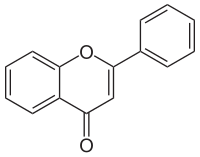
Photo from wikipedia
Introduction: Skin is highly prone to radiation damage. Radiation burn is defined as damage to the skin or other biological tissues induced by radiofrequency or ionizing radiation. Vascular endothelial growth… Click to show full abstract
Introduction: Skin is highly prone to radiation damage. Radiation burn is defined as damage to the skin or other biological tissues induced by radiofrequency or ionizing radiation. Vascular endothelial growth factor (VEGF) is a heparin-binded pro-angiogenic factor. Flavonoids belong to a family of polyphenol chemical compounds that are frequently present in fruits and vegetables. Hesperidin is an agent belonging to the flavonoid family. The aim of this study is to investigate whether hesperidin can affect the VEGF gene expression in rat skin following gamma irradiation or not. Materials and Methods: A total number of 36 male Sprague-Dawley rats were divided into three groups. First group: radiation group (n = 12), second group: radiation + hesperidin-treated group (n = 12), and third group: untreated control group (n = 12). The hesperidin administration dose was 100 mg/kg body weight. The rats received a 22 Gy single dose at a dose rate of about 0.3 Gy/min using a cobalt-60 external beam radiotherapy unit. The animals were euthanized 24 h postirradiation. VEGF gene expression data were analyzed using the equation 2–ΔΔCT, where ΔΔCT = (Threshold cycle [CT], of target gene – CT of housekeeping gene)treated group– (CT of target gene – CT of housekeeping gene)untreated control group. Glyceraldehyde-3-phosphate dehydrogenase gene was used as a housekeeping gene. Results: VEGF gene in the radiation + hesperidin group overexpressed 25-fold relative to the control group. In addition, VEGF gene in the radiation group underexpressed 0.15-fold relative to the control group. When the three groups were compared relative to each other using the Kruskal–Wallis test, P < 0.001 was obtained. Based on the Mann–Whitney U-test, when all groups were compared to each in a binary model, P = 0.001 was achieved. These tests all showed statistically significant changes in VEGF gene expression. Conclusions: We can conclude that hesperidin is a potent angiogenic factor. Hesperidin as a radioprotector can initiate angiogenesis by VEGF gene induction. It may stimulate epithelialization, collagen deposition, and enhanced cellular proliferation. These changes can together accelerate wound healing, in particular, radiation-induced skin damage.
Journal Title: Journal of Cancer Research and Therapeutics
Year Published: 2018
Link to full text (if available)
Share on Social Media: Sign Up to like & get
recommendations!